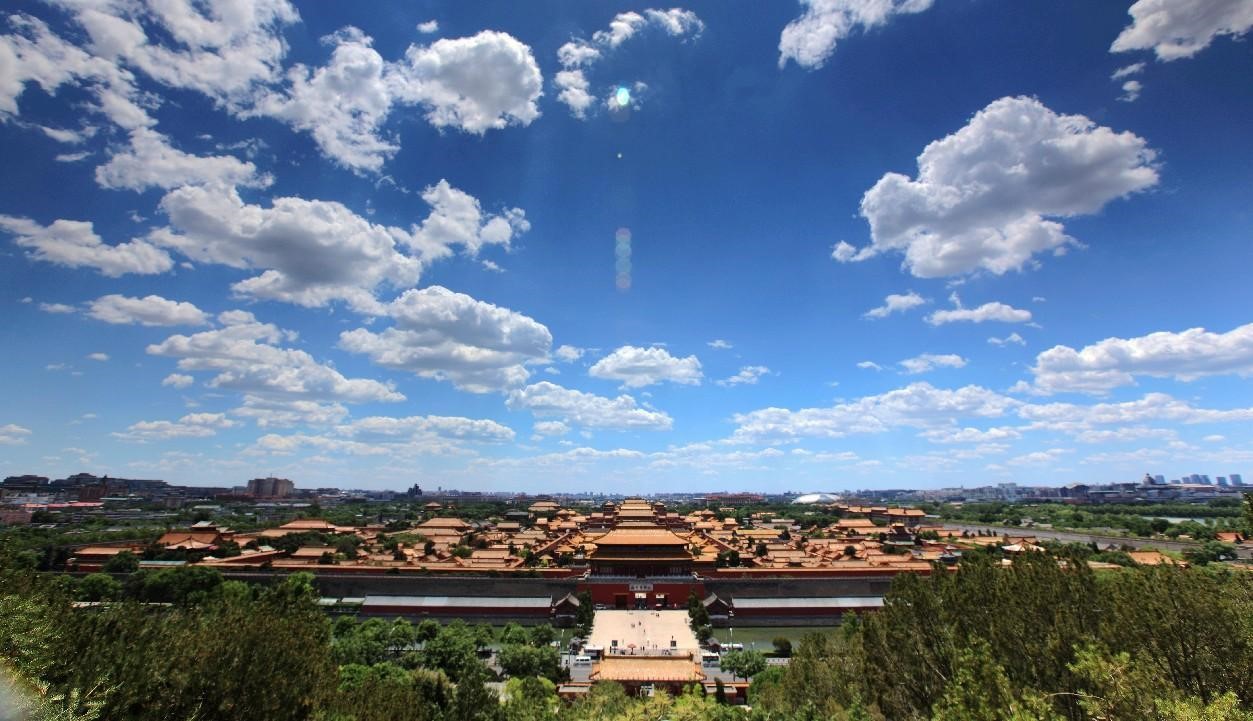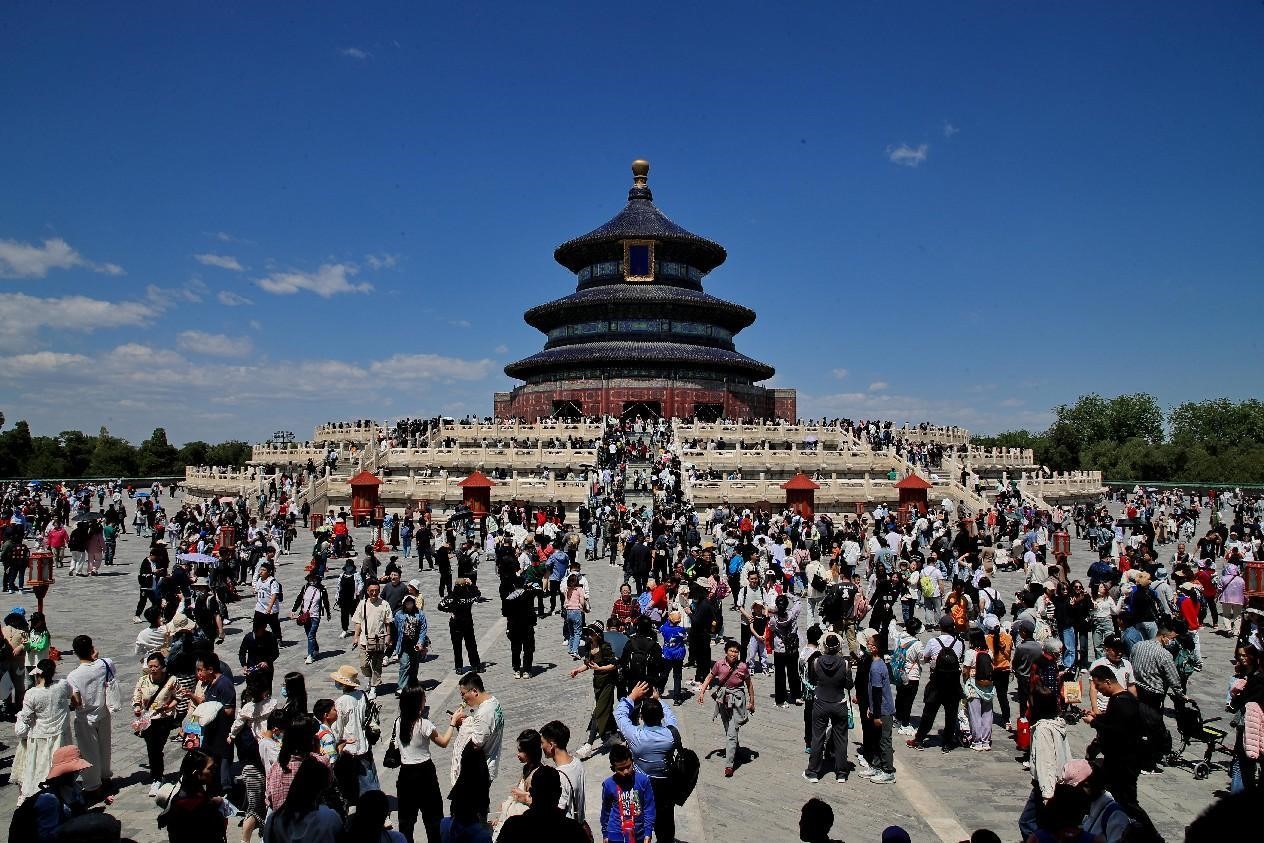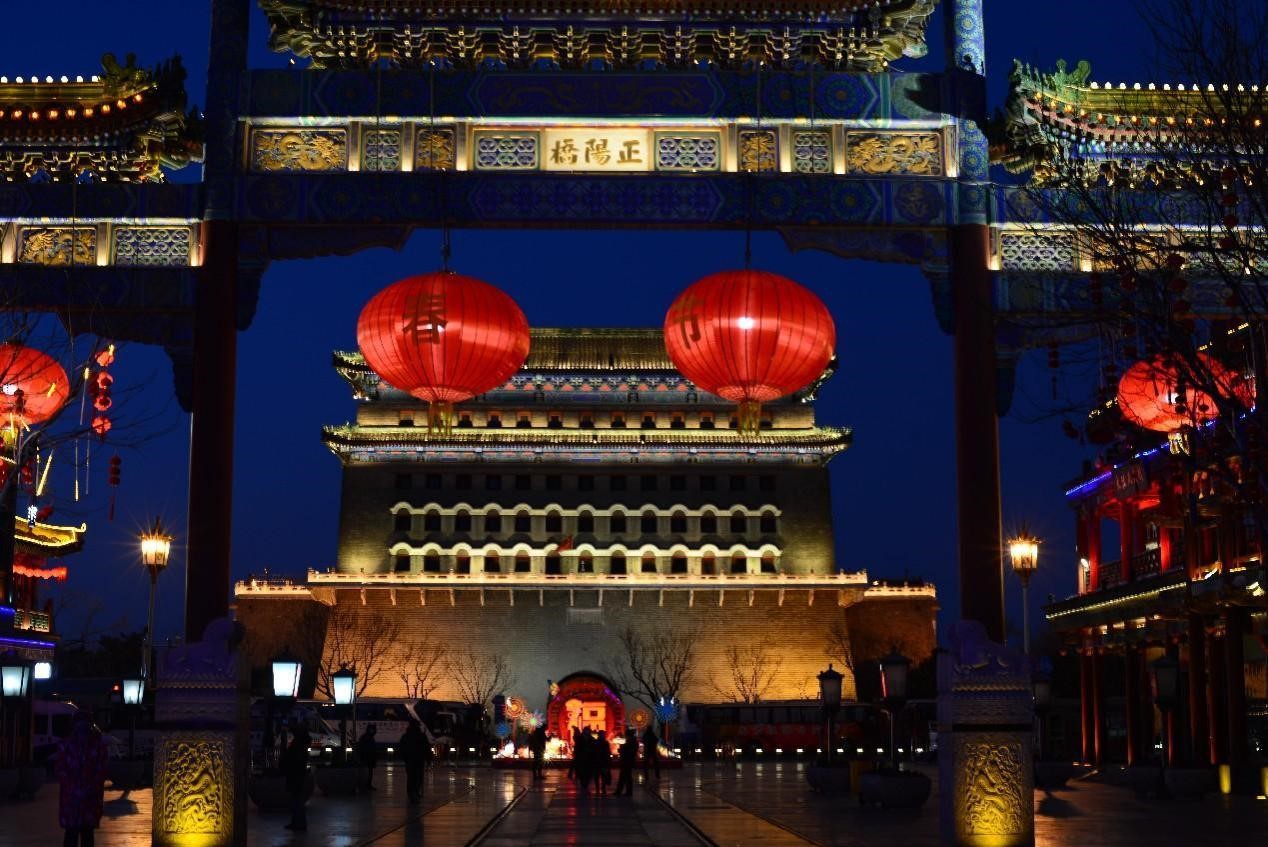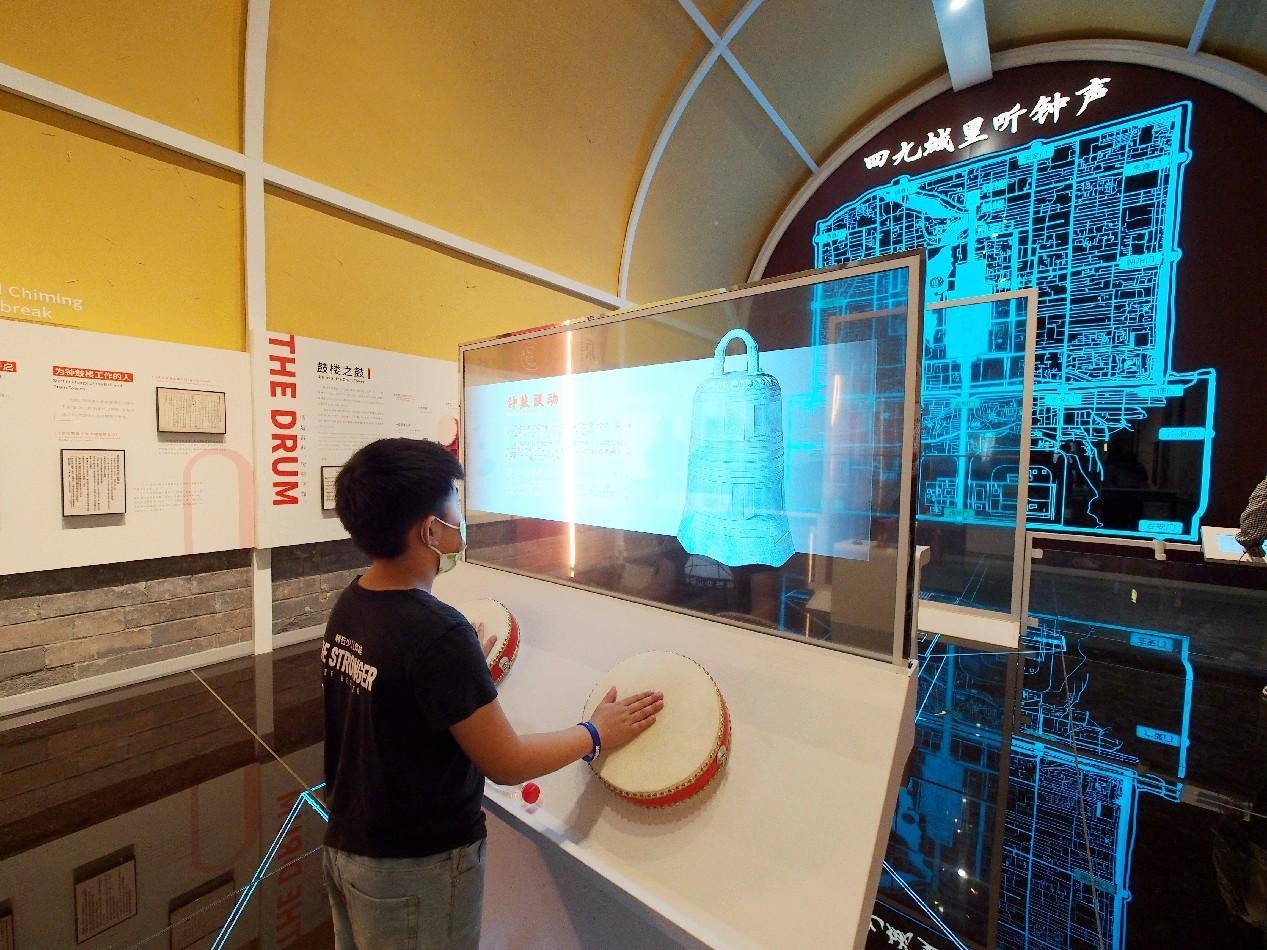Breathing new life into Beijing Central Axis with digital tools

Photo shows the Palace Museum in Beijing. (People's Daily Online/Ding Bangxue)
In Beijing, there is a north-south axis known as the Beijing Central Axis, or Zhongzhouxian, running through the city.
First created in the Yuan Dynasty (1271-1368), the 7.8-kilometer central axis serves the function of a "book spine", forming a unique Beijing city pattern of bilateral symmetry and solemnity.
It stretches from the Yongding Gate in the south of the city and the Drum Tower and Bell Tower in the north, crossing the Wanning Bridge, the Jingshan Mountain, the Palace Museum, the Duanmen Gate, Tian'anmen Square and its adjacent areas, the Zhengyang Gate, and the street remains of the southern section of the central axis.
The Imperial Ancestral Temple, the Altar of Land and Grain, the Temple of Heaven, and the Temple of Agriculture sit symmetrically in the west and east wings of the central axis.
As the best preserved core area of the old city of Beijing, it contains the essence of ancient architecture of Beijing, and carries on the memorable moments of the Chinese civilization.
It connects many historical sites, including 3 World Heritage Sites and 11 major historical and cultural sites protected at the national level, which embody the great creativity and outstanding talent of the Chinese nation in urban planning and construction.
Today, with the rapid development of science and technology, the ancient central axis is better protected and inherited, blossoming with dazzling brilliance.
As night fell, in front of the Yongding Gate, a vehicle equipped with a laser modeling system slowly drove by, meticulously measuring and recording details about the Beijing Central Axis roadway and neighboring structures.

People visit the Temple of Heaven in Beijing. (People's Daily Online/Liu Xianguo)
At daybreak, surveying and mapping engineers had already positioned equipment before a hall of the Temple of Agriculture, collecting statistics and portraying each facet.
The greatest feature of the Beijing Central Axis is that it has an undulating layout and maintains mirror symmetry on its east and west sides, said Tao Yingchun, director of the big data center of the Beijing Institute of Surveying and Mapping, adding that it is impossible for a visitor to get an overview of the entire central axis at any one heritage site.
However, digital products can break through the limitations of time and space, allowing people to appreciate the unique charm of the central axis, Tao noted.
In 2020, the Beijing Institute of Surveying and Mapping established a technical team of nearly 200 members to carry out ultra-fine surveying and 3D modeling for heritage elements along the central axis. For the first time, the central axis was digitally duplicated with digital twin technology.
The team has collected over 1TB of data, including information about the main roads within the heritage area, Tian'anmen Square and its adjacent areas, the Yongding Gate, the Drum Tower and Bell Tower, and the Temple of Agriculture.
So far, the first phase of the digital twin project has been completed. The final digital twin of the central axis will provide a complete spatial database for monitoring, managing, protecting and utilizing the central axis heritage.
"From paper maps to digital maps and real-scene 3D products, our surveying and mapping of the central axis is becoming more and more refined. Overlaying historical and present images through modern technologies, we can see that the central axis has been 'growing' all along." said Tao.
As the sunshade curtains lowered and the lights dimmed, the first-floor central archway of the Drum Tower was turned into an "immersive theater," where visitors could experience the changes of the central axis through shifts in light and shadow.

Photo shows a night view of the Zhengyang Gate in Beijing. (People's Daily Online/Zhang Jun)
This was a digital light show that utilized projection distortion correction technology and spatial sound zoning to combine music, drum beats, and images with the majestic architectural space, fully demonstrating the architectural beauty of the Drum Tower and presenting cultural relics and historical sites in a brand new way.
"The history of Drum Tower and Bell Tower is an epitome of Beijing's urban history. It carries warm and intimate memories for urban residents," said He Yan, leader of an exhibition team for the Beijing Central Axis. The team collected over 300 old photos of the Drum Tower and Bell Tower from different periods of time, along with various sounds related to the central axis, to evoke citizens' cherished memories of old Beijing.
The archway of the Drum Tower once served as a gift shop. After vacating and renovating work, the time-reporting facility of the Yuan, Ming and Qing dynasties (1271-1911) restored its original appearance.
Along the central axis, a series of historic buildings have been repaired and renovated, adding to the dignified and majestic old-city style of the city.
The Zhengyang Gate is an important heritage site along the central axis. During the restoration process of the gate's Arrow Tower, great efforts were made to retain as much historic authenticity as possible. The restoration kept the same materials, forms, artisanal techniques, and methods that were originally used, in every detail.
"We for the first time applied intelligent construction technologies in ancient building renovation," said Li Wanbo, head of the ancient construction division of Beijing Construction Engineering Group No.6 Construction Engineering Co., Ltd.
Using architectural information modeling, 3D scanning, panoramic imaging and other technologies, engineers can make more science-based renovation plans, Li said.
"For example, if a part of a building's wall is bulged, it is very difficult to determine the cause by the naked eye. A 'CT scan' allows us to clearly see the 'health status' of the cultural relics, and precisely implement 'minimally invasive surgery' on the damaged part, achieving minimum intervention for the ancient building renovation," Li explained.

A child experiences virtual drumming at an exhibition held at the Drum Tower in Beijing. (People's Daily Online/Du Jianpo)
The Zhengyang Gate tower is one of the major stops for Beijing swifts, which fly from Africa to Beijing every year to nest and breed. The scene of Beijing swifts flying around the Zhengyang Gate has lasted for over 600 years.
When the Arrow Tower of the Zhengyang Gate was renovated, these swifts were carefully protected.
"Ancient architectures are tangible cultural heritage, and swifts are living 'cultural heritage.' Both of them need protection. We waited for the swifts to fly away before erecting scaffolding to minimize disturbance to them," said Guan Zhanxiu, director of the heritage conservation center of the Beijing Central Axis.
The Wanning Bridge, built in the Yuan Dynasty, is at the intersection of the central axis and the Beijing-Hangzhou Grand Canal.
A mobile app has been developed to guide tourists to the site with augmented reality. In the app, a cute "water dragon" would lead tourists into the bustling market, learn kite-making techniques and watch how Beijing-style Qipao, a traditional wearing of Chinese women, is made.
This app is a part of a "digital central axis" project built by the culture and tourism bureau of Beijing's Xicheng district. Relying on large-scale 3D map construction, high-precision spatial computation and other technologies by Beijing-based tech firm Hereto, the project digitally restores historical scenes and disappeared architectures along the central axis, providing the public with an immersive experience.
"The Beijing Central Axis embodies concepts such as centrality, harmony, uprightness, and unity of man and nature," said Chen Mingjie, director of the Beijing Municipal Cultural Heritage Bureau.
"We must use digital technology and other means to turn the ancient into the fashionable, make the profound Chinese culture more accessible, interpret the value of the central axis, and protect, inherit and utilize this unique cultural heritage," Chen added.
Related articles
-
 The Summer Palace, an imperial garden in Beijing
The Summer Palace, an imperial garden in BeijingMore
-
 The Central Axis and the history of Beijing
The Central Axis and the history of BeijingMore
-
 Beijing forum spotlights relevance of Mencius’ wisdom in modern society
Beijing forum spotlights relevance of Mencius’ wisdom in modern societyMore
-
 Intangible cultural heritage enriches appeal of Beijing Wtown
Intangible cultural heritage enriches appeal of Beijing WtownMore
-
 The wonders of the Wall
The wonders of the WallMore
-
 The Forbidden City, a shining gem on the Beijing Central Axis
The Forbidden City, a shining gem on the Beijing Central AxisMore
